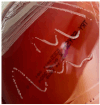Rare or Unusual Non-Fermenting Gram-Negative Bacteria: Therapeutic Approach and Antibiotic Treatment Options
- PMID: 40149115
- PMCID: PMC11939765
- DOI: 10.3390/antibiotics14030306
Rare or Unusual Non-Fermenting Gram-Negative Bacteria: Therapeutic Approach and Antibiotic Treatment Options
Abstract
Non-fermenting Gram-negative bacteria (NFGNB) are a heterogeneous group of opportunistic pathogens increasingly associated with healthcare-associated infections. While Pseudomonas aeruginosa, Acinetobacter baumannii, and Stenotrophomonas maltophilia are well known, rarer species such as Burkholderia cepacia complex, Achromobacter spp., Chryseobacterium spp., Elizabethkingia spp., Ralstonia spp., and others pose emerging therapeutic challenges. Their intrinsic and acquired resistance mechanisms limit effective treatment options, making targeted therapy essential. Objectives: This narrative review summarizes the current understanding of rare and unusual NFGNB, their clinical significance, resistance profiles, and evidence-based therapeutic strategies. Methods: A literature review was conducted using PubMed, Scopus, and Web of Science to identify relevant studies on the epidemiology, antimicrobial resistance, and treatment approaches to rare NFGNB. Results: Rare NFGNB exhibits diverse resistance mechanisms, including β-lactamase production, efflux pumps, and porin modifications. Treatment selection depends on species-specific susceptibility patterns, but some cornerstones can be individuated. Novel β-lactam/β-lactamase inhibitors and combination therapy approaches are being explored for multidrug-resistant isolates. However, clinical data remain limited. Conclusions: The increasing incidence of rare NFGNB requires heightened awareness and a tailored therapeutic approach. Given the paucity of clinical guidelines, antimicrobial stewardship and susceptibility-guided treatment are crucial in optimizing patient outcomes.
Keywords: antibiotic treatment; antimicrobial resistance; non-fermenter bacteria; non-fermenting Gram-negative bacteria; rare pathogens; therapeutic strategies.
Conflict of interest statement
The authors declare no conflicts of interest.
Figures







References
-
- Casale R., Boattini M., Comini S., Bastos P., Corcione S., De Rosa F.G., Bianco G., Costa C. Clinical and Microbiological Features of Positive Blood Culture Episodes Caused by Non-Fermenting Gram-Negative Bacilli Other than Pseudomonas and Acinetobacter Species (2020–2023) Infection. 2024;53:183–196. doi: 10.1007/s15010-024-02342-6. - DOI - PMC - PubMed
Publication types
LinkOut - more resources
Full Text Sources
Miscellaneous

